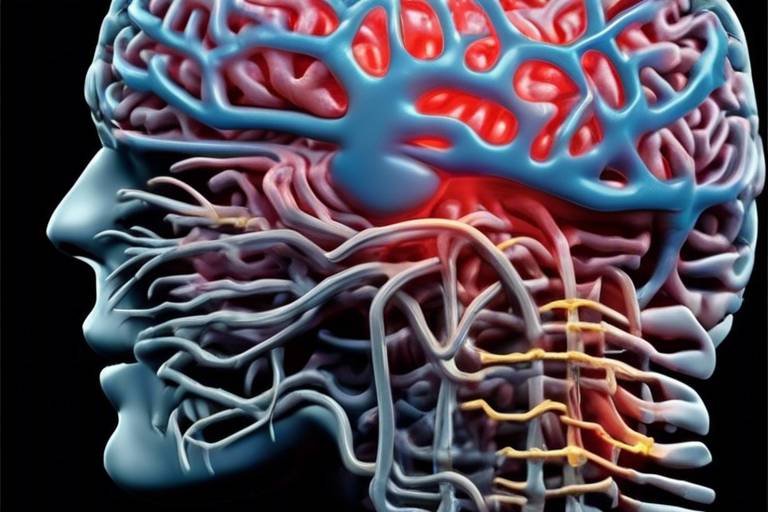The Latest Research on the Effects of Aging on the Brain
Aging is an inevitable part of life, and it brings with it a myriad of changes, especially in our brains. The latest research sheds light on how these changes affect not just our cognitive abilities, but also the very structure and function of our brains. As we age, we may notice that remembering names becomes a challenge, or that processing information takes a little longer than it used to. But why does this happen? What’s going on in our brains as we age? This article dives deep into the biological mechanisms at play, discussing neurodegeneration, neurotransmitter changes, and the overall impact on cognitive function.
As we age, our brains undergo several biological processes that can lead to noticeable changes in our mental faculties. One of the primary mechanisms is neurodegeneration, which refers to the gradual loss of neurons and the connections between them. This process can be exacerbated by factors such as genetics, lifestyle choices, and environmental influences. Alongside neurodegeneration, there are changes in neurotransmitter levels, which are crucial for communication between neurons. For instance, the levels of dopamine, serotonin, and acetylcholine can decline, affecting mood, memory, and overall cognitive function.
Moreover, the brain's structure itself changes with age. The volume of certain areas, such as the hippocampus (vital for memory formation), tends to shrink, leading to difficulties in learning new information or recalling past experiences. This decline in volume is not only a result of neurodegeneration but also reflects a decrease in neurogenesis, the process by which new neurons are formed. Understanding these processes can help us find ways to mitigate their effects and maintain cognitive health as we age.
Despite the challenges posed by aging, one of the most fascinating aspects of the brain is its ability to adapt, known as neuroplasticity. This phenomenon allows the brain to reorganize itself by forming new neural connections throughout life. However, the efficiency of neuroplasticity tends to decline with age. This decline can make it more challenging for older adults to learn new skills or adapt to new environments. Yet, the good news is that engaging in stimulating activities can enhance neuroplasticity, helping to maintain cognitive abilities even in later years.
One of the most effective ways to promote neuroplasticity is through physical activity. Research shows that regular exercise can significantly enhance brain health. Not only does it increase blood flow to the brain, but it also stimulates the release of growth factors that promote the survival of neurons. This is crucial because it helps counteract some of the age-related decline we experience. Furthermore, exercise has been linked to improved mood and reduced symptoms of anxiety and depression, which can further support cognitive health.
When it comes to choosing the right types of exercise, variety is key. Here are some beneficial forms of exercise that have been shown to promote brain health:
- Aerobic Exercises: Activities like walking, swimming, or cycling can boost cardiovascular health and improve blood flow to the brain.
- Strength Training: Lifting weights or using resistance bands can enhance muscle mass and bone density, contributing to overall physical health.
- Balance Exercises: Practices such as tai chi or yoga can improve coordination and reduce the risk of falls, which is particularly important for older adults.
To optimize brain health, older adults should aim for at least 150 minutes of moderate aerobic activity each week, combined with strength training exercises on two or more days. It’s essential to find activities that are enjoyable and can be incorporated into daily routines, making it easier to stick with them in the long run.
What we eat plays a crucial role in how our brains age. A diet rich in nutrients can support cognitive function and overall brain health. Foods high in antioxidants, healthy fats, vitamins, and minerals are particularly beneficial. For instance, omega-3 fatty acids found in fish, nuts, and seeds are known to support brain function and may even reduce the risk of cognitive decline. Additionally, following dietary patterns such as the Mediterranean diet, which emphasizes whole grains, fruits, vegetables, and healthy fats, has been associated with better cognitive health in older adults.
Another significant factor influencing brain health as we age is social engagement. Maintaining strong social connections can help protect against cognitive decline and enhance mental well-being. Engaging with friends and family, participating in community activities, or even joining clubs can provide mental stimulation and emotional support. The benefits of social interaction extend beyond mere companionship; they can also lead to improved cognitive function and a greater sense of purpose in life.
Many communities offer programs aimed at promoting social engagement among older adults. These initiatives can include group exercise classes, art workshops, or volunteer opportunities. Participating in these programs not only fosters social connections but also provides cognitive stimulation, which is vital for maintaining brain health.
In today's digital age, technology plays a crucial role in cognitive health. Various digital tools and cognitive training programs are designed to stimulate the brain and enhance cognitive function. Many of these programs are accessible and user-friendly, making them ideal for older adults. Engaging in brain games, puzzles, or memory exercises can help keep the mind sharp and improve cognitive performance.
Q: Can cognitive decline be reversed?
A: While some cognitive decline is a natural part of aging, engaging in regular exercise, maintaining a healthy diet, and staying socially active can help mitigate its effects.
Q: How often should older adults exercise?
A: Older adults should aim for at least 150 minutes of moderate aerobic activity each week, along with strength training exercises on two or more days.
Q: What role does diet play in brain health?
A: A balanced diet rich in antioxidants, healthy fats, and essential nutrients supports cognitive function and can help reduce the risk of cognitive decline.

Understanding Brain Aging
Aging is a natural process that affects every part of our body, and the brain is no exception. As we grow older, our brains undergo a series of biological changes that can impact their structure and function. One of the most significant processes involved in brain aging is neurodegeneration, where neurons—the fundamental units of the brain—begin to deteriorate. This decline can lead to a variety of cognitive impairments, affecting memory, decision-making, and overall mental agility.
Moreover, the brain's neurotransmitter levels also change with age. Neurotransmitters are the chemical messengers that facilitate communication between neurons. As we age, the production of certain neurotransmitters, such as dopamine and serotonin, tends to decrease. This reduction can contribute to feelings of depression and anxiety, further complicating cognitive health. The interplay between neurodegeneration and neurotransmitter changes can create a perfect storm, leading to a decline in cognitive abilities that many older adults experience.
In addition to these biological factors, the brain's structural integrity is also compromised with age. Studies have shown that the volume of certain brain regions, particularly the hippocampus—which plays a crucial role in memory—tends to shrink over time. This reduction in size can lead to difficulties in forming new memories and retrieving existing ones. But it’s not all doom and gloom! Understanding these changes can pave the way for potential interventions that can help mitigate the effects of aging on the brain.
Interestingly, while we can't stop aging, we can influence how it affects our brain health. Engaging in activities that promote cognitive resilience, such as lifelong learning, social engagement, and physical exercise, can make a significant difference. For instance, research suggests that older adults who challenge their brains with puzzles, reading, or learning new skills tend to maintain better cognitive function compared to those who remain inactive.
In summary, understanding brain aging involves recognizing the complex interplay of neurodegeneration, changes in neurotransmitter levels, and structural alterations within the brain. By acknowledging these factors, we can better equip ourselves with strategies to enhance our cognitive health as we age. The journey of aging is not just about decline; it’s also about adaptation and resilience. So, let's embrace the aging process with knowledge and proactive strategies!

Neuroplasticity in Older Adults
As we age, one of the most fascinating concepts that emerges is neuroplasticity. This term refers to the brain's remarkable ability to reorganize itself by forming new neural connections throughout life. You might think of neuroplasticity as the brain's way of adapting to changes, much like a river carving a new path when faced with obstacles. In older adults, this adaptability becomes crucial for maintaining cognitive functions and learning new skills.
Research has shown that while neuroplasticity may decline with age, it doesn't disappear entirely. In fact, older adults can still experience significant changes in brain structure and function, especially when they engage in activities that challenge their cognitive abilities. This is where the magic happens! When older individuals participate in learning experiences, whether it's picking up a new hobby or mastering a musical instrument, their brains can create new pathways, enhancing cognitive resilience.
One of the key factors influencing neuroplasticity in older adults is mental engagement. Activities that require critical thinking, problem-solving, and creativity can stimulate the brain and promote neuroplastic changes. For instance, puzzles, reading, and playing strategy games are not just fun; they are also powerful tools for keeping the brain agile. Imagine your brain as a muscle that needs regular exercise to stay strong and flexible. The more you challenge it, the more it adapts and grows.
Moreover, social interactions play a pivotal role in fostering neuroplasticity. Engaging in conversations, sharing experiences, and participating in group activities can stimulate cognitive processes, leading to improved brain health. Think of social engagement as a workout for your brain, where every laugh, story, and shared moment contributes to building a stronger mental network.
It's also essential to highlight that neuroplasticity isn't a one-size-fits-all phenomenon. Factors such as genetics, lifestyle choices, and overall health can significantly influence the extent and efficiency of neuroplastic changes. For example, individuals who lead an active lifestyle, maintain a balanced diet, and manage stress effectively tend to exhibit greater neuroplasticity. In contrast, those who are sedentary or isolated may experience more pronounced cognitive decline.
In summary, while aging presents challenges to our cognitive abilities, the concept of neuroplasticity offers hope. By engaging in mentally stimulating activities, nurturing social connections, and maintaining a healthy lifestyle, older adults can harness the power of neuroplasticity to promote cognitive health and adaptability. So, the next time you pick up a new hobby or call a friend, remember that you are not just enjoying life; you are actively reshaping your brain!
- What is neuroplasticity? Neuroplasticity is the brain's ability to reorganize itself by forming new neural connections throughout life.
- Can older adults experience neuroplasticity? Yes, older adults can still experience neuroplastic changes, especially through engaging in mentally stimulating activities.
- How can I promote neuroplasticity as I age? Engaging in challenging cognitive tasks, maintaining social connections, and leading a healthy lifestyle can all promote neuroplasticity.
- Are there specific activities that enhance neuroplasticity? Activities like puzzles, reading, learning new skills, and socializing are great for enhancing neuroplasticity.

The Role of Exercise
When it comes to maintaining a healthy brain, exercise is a powerhouse. You might be wondering, how can something as simple as moving our bodies have such a profound effect on our minds? Well, let’s dive into the fascinating world of physical activity and its impact on brain health, especially as we age. Research shows that engaging in regular exercise not only promotes physical well-being but also enhances neuroplasticity, which is the brain's ability to adapt and reorganize itself. This is crucial for older adults, as neuroplasticity tends to decline with age, leading to cognitive challenges.
One of the most exciting aspects of exercise is its ability to stimulate the release of neurotransmitters like dopamine and serotonin, which play significant roles in mood regulation and cognitive function. Imagine your brain as a bustling city; exercise acts like a well-maintained road system, ensuring that messages travel smoothly and efficiently. Without this, the city could become congested, leading to slower response times and decreased cognitive abilities.
Furthermore, studies have shown that physical activity can help reduce the risk of developing neurodegenerative diseases such as Alzheimer's. It’s like putting on a protective shield for your brain. Regular exercise increases blood flow to the brain, which delivers essential nutrients and oxygen, helping to keep those brain cells alive and thriving. It’s not just about lifting weights or running marathons; even moderate activities like walking can yield significant benefits. The key is consistency!
Now, let’s break down the types of exercise that are particularly beneficial for older adults:
- Aerobic Exercise: Activities like walking, swimming, and cycling can enhance cardiovascular health and improve overall brain function.
- Strength Training: Lifting weights or using resistance bands helps maintain muscle mass and supports cognitive health by promoting hormone release.
- Balance Exercises: Practices like tai chi or yoga not only improve physical stability but also enhance mental focus and reduce the risk of falls.
Incorporating these exercises into a routine can be incredibly rewarding. But you might ask, how much exercise is enough? The general recommendation for older adults is at least 150 minutes of moderate-intensity aerobic activity each week, along with strength training exercises on two or more days. This may sound daunting, but breaking it down into manageable chunks can make it more achievable. For instance, a brisk 30-minute walk five days a week can do wonders for your brain health!
In summary, the role of exercise in supporting brain health as we age cannot be overstated. It’s a natural, effective way to enhance neuroplasticity, boost mood, and reduce the risk of cognitive decline. So, why not lace up those sneakers and start moving? Your brain will thank you!
Q: How often should older adults exercise?
A: Older adults should aim for at least 150 minutes of moderate-intensity aerobic activity each week, along with strength training exercises on two or more days.
Q: What types of exercise are best for brain health?
A: Aerobic exercises, strength training, and balance exercises are all beneficial for maintaining brain health in older adults.
Q: Can I start exercising if I haven't been active for a while?
A: Absolutely! It's important to start slowly and gradually increase your activity level. Consulting with a healthcare provider can help you develop a safe exercise plan.

Types of Beneficial Exercises
When it comes to maintaining brain health as we age, engaging in the right types of exercise can be a game changer. It's not just about keeping our bodies fit; it's about ensuring our minds stay sharp and agile. Different forms of exercise play unique roles in promoting cognitive function and enhancing neuroplasticity, which is the brain's ability to adapt and reorganize itself. So, let’s dive into the types of beneficial exercises that can help keep our brains in top shape!
First up, we have aerobic exercises. These are activities that get your heart pumping and blood flowing, which is crucial for brain health. Think of brisk walking, cycling, swimming, or even dancing! Engaging in aerobic activities increases the heart rate, which in turn boosts the flow of oxygen and nutrients to the brain. Studies have shown that regular aerobic exercise can lead to improvements in memory and cognitive function, making it a must-have in your exercise routine.
Next, let’s talk about strength training. You might be surprised to learn that lifting weights or doing resistance exercises can also benefit your brain. These activities help in building muscle mass, which is essential for overall health, but they also contribute to brain health by enhancing the production of brain-derived neurotrophic factor (BDNF). BDNF is a protein that supports the survival of existing neurons and encourages the growth of new neurons and synapses. So, don’t skip that weightlifting session!
Another important category is balance exercises. As we age, maintaining balance becomes crucial not just for preventing falls but also for enhancing cognitive function. Activities like tai chi, yoga, or simple balance exercises can improve your stability and coordination, which are linked to better brain health. These exercises require concentration and mindfulness, which can further stimulate cognitive processes.
Moreover, engaging in flexibility exercises is also beneficial. Stretching and flexibility routines not only help in keeping your body limber but also promote blood circulation throughout the body, including the brain. This can be particularly helpful in reducing stress levels, which is vital because chronic stress can negatively impact brain health.
To wrap it up, incorporating a mix of these exercise types into your weekly routine can have profound effects on both your physical and mental well-being. Here’s a quick summary of the types of beneficial exercises:
| Type of Exercise | Benefits for Brain Health |
|---|---|
| Aerobic Exercises | Improves blood flow, enhances memory and cognitive function. |
| Strength Training | Increases muscle mass, boosts BDNF production. |
| Balance Exercises | Enhances stability, promotes cognitive processes. |
| Flexibility Exercises | Improves circulation, reduces stress levels. |
Incorporating a variety of these exercises into your routine not only keeps your body fit but also plays a crucial role in maintaining and enhancing your cognitive abilities as you age. Remember, it's never too late to start, and every little bit counts!
- How often should I exercise for optimal brain health? Aim for at least 150 minutes of moderate aerobic activity per week, combined with strength training on two or more days.
- Can I do these exercises at home? Absolutely! Many aerobic, strength, and balance exercises can be done at home with little to no equipment.
- Is it too late to start exercising if I'm older? Not at all! It's never too late to start exercising, and even small amounts of physical activity can be beneficial.

Exercise Recommendations
When it comes to maintaining brain health as we age, exercise is not just beneficial; it's essential. The key is to incorporate a variety of activities that cater to different aspects of fitness. So, what should older adults aim for in their exercise routines? Health experts generally recommend a combination of aerobic, strength training, and flexibility exercises. This trifecta not only helps in keeping the body fit but also plays a crucial role in enhancing neuroplasticity—the brain's ability to adapt and reorganize itself.
According to the American Heart Association, older adults should strive for at least 150 minutes of moderate aerobic activity each week. This could include brisk walking, swimming, or cycling. You might be wondering, "How can I fit that into my busy schedule?" The good news is that these minutes can be broken down into manageable chunks. For instance, a 30-minute walk five times a week is a great start!
In addition to aerobic exercises, it's equally important to include strength training at least twice a week. This can involve using resistance bands, light weights, or even bodyweight exercises like squats and push-ups. Strength training helps to combat the natural decline in muscle mass and strength that accompanies aging, which in turn supports better balance and coordination—crucial factors for preventing falls.
Flexibility exercises should not be overlooked either. Simple stretching routines or activities like yoga can significantly improve flexibility and joint health. They also promote relaxation and stress relief, which are important for overall well-being. Consider incorporating these stretches into your daily routine, perhaps after your aerobic or strength training sessions.
To summarize, here’s a quick overview of the exercise recommendations for older adults:
| Type of Exercise | Frequency | Examples |
|---|---|---|
| Aerobic | 150 minutes/week | Brisk walking, swimming, cycling |
| Strength Training | 2 times/week | Resistance bands, light weights, squats |
| Flexibility | Daily | Stretching, yoga |
Ultimately, the goal is to create a balanced routine that is enjoyable and sustainable. Remember, it's not just about the quantity of exercise but the quality and consistency. So, whether you’re taking a leisurely stroll in the park or joining a local fitness class, the important thing is to keep moving. As you embark on this journey, don’t hesitate to consult with a healthcare provider or a fitness professional to tailor a program that suits your individual needs. Happy exercising!
- How much exercise should older adults do each week? Aim for at least 150 minutes of moderate aerobic activity, along with strength training twice a week.
- Can I break up my exercise into smaller sessions? Absolutely! Shorter sessions throughout the week can be just as effective.
- What types of exercises are best for brain health? Aerobic, strength training, and flexibility exercises all contribute positively to brain health.
- Is it safe for older adults to start a new exercise program? Yes, but it’s wise to consult with a healthcare provider before beginning any new fitness regimen.

Nutrition and Brain Health
When it comes to maintaining a sharp mind as we age, nutrition plays a pivotal role. Just like a car needs the right fuel to run smoothly, our brains require specific nutrients to function optimally. Research has shown that certain dietary patterns can either promote cognitive health or contribute to decline. So, what should we be eating to keep our brains in top shape? Let's dive into the delicious world of brain-boosting foods!
First off, it's essential to understand the impact of omega-3 fatty acids. These healthy fats, found in fish like salmon and mackerel, are crucial for brain health. They help build cell membranes in the brain and are linked to improved cognitive function. Studies suggest that individuals with higher omega-3 levels tend to have better memory and overall cognitive performance. If you're not a fan of fish, don't worry! You can also find omega-3s in flaxseeds, walnuts, and chia seeds.
Next up is the power of antioxidants. Foods rich in antioxidants, such as berries, dark chocolate, and leafy greens, help combat oxidative stress, which can damage brain cells. For instance, blueberries have been dubbed a “superfood” for the brain due to their high levels of flavonoids, which have been shown to enhance communication between brain cells. Incorporating a variety of colorful fruits and vegetables into your diet can ensure you're getting a wide range of these protective compounds.
Another key player in brain health is whole grains. Foods like oats, brown rice, and quinoa provide a steady supply of glucose, which is essential for brain function. Unlike sugary snacks that can cause spikes and crashes in energy, whole grains release glucose slowly, keeping your brain fueled throughout the day. This steady energy can help improve concentration and mental clarity.
Moreover, we can't overlook the importance of hydration. Our brains are about 75% water, and staying hydrated is vital for maintaining cognitive function. Dehydration can lead to confusion, memory issues, and difficulty concentrating. So, make sure to drink plenty of water and consider incorporating hydrating foods like cucumbers, oranges, and watermelon into your meals.
Let's not forget about the significance of vitamins and minerals. Nutrients such as vitamin E, vitamin B12, and folate have been linked to cognitive health. For example, vitamin E, found in nuts and seeds, is an antioxidant that protects brain cells from oxidative stress. On the other hand, B vitamins play a crucial role in producing neurotransmitters, which are essential for communication between brain cells. A deficiency in these vitamins can lead to cognitive decline, making it important to include a variety of foods in your diet to cover your nutritional bases.
In summary, a well-rounded diet rich in omega-3 fatty acids, antioxidants, whole grains, and essential vitamins can significantly impact brain health as we age. By making mindful food choices, we can support our cognitive function and potentially ward off age-related decline. So, the next time you're planning your meals, think about how you can nourish your brain!
- What are the best foods for brain health? Foods rich in omega-3 fatty acids, antioxidants, whole grains, and essential vitamins are excellent for brain health.
- How much water should I drink for optimal brain function? Aim for at least 8 cups (64 ounces) of water daily, but individual needs may vary based on activity level and climate.
- Can diet really affect cognitive decline? Yes, a balanced diet can significantly impact cognitive health and help mitigate age-related decline.

Impact of Social Engagement
When we think about aging, we often focus on physical health or cognitive decline, but we shouldn't overlook the profound on our brain health. Imagine your brain as a garden; without regular care and interaction, weeds of loneliness and isolation can take root, stifling the vibrant blooms of cognitive function. Research has shown that maintaining strong social connections can be a powerful antidote to age-related cognitive decline, enhancing not just our mental faculties but also our overall emotional well-being.
Social engagement encompasses a wide range of activities, from casual chats with neighbors to participating in community events, and even using technology to connect with family and friends. These interactions stimulate our brains, keeping them active and engaged. It's like a workout for your mind! When we engage socially, our brains are challenged to process information, understand emotions, and navigate complex conversations, all of which can help to build cognitive reserves that may protect against the effects of aging.
Moreover, studies indicate that older adults who maintain strong social networks tend to experience slower rates of cognitive decline. This correlation can be attributed to several factors:
- Emotional Support: Engaging with others provides emotional sustenance, reducing feelings of loneliness and depression, which are known to negatively impact cognitive health.
- Cognitive Stimulation: Social interactions often involve discussions that require critical thinking and problem-solving, which can enhance mental agility.
- Physical Activity: Many social activities, such as group exercise classes or community outings, naturally incorporate physical movement, further benefiting brain health.
Interestingly, the quality of social interactions matters just as much as the quantity. Deep, meaningful relationships can have a more significant impact than a large number of acquaintances. It's akin to having a few close friends who know you well versus a crowd of people who don’t really connect with you. The former provides a sense of belonging and understanding, which can be incredibly protective against cognitive decline.
As we age, it’s crucial to seek out opportunities for social engagement. Communities are increasingly recognizing this need and creating programs designed to foster connections among older adults. These initiatives can range from local clubs and classes to online forums and virtual meetups, ensuring that everyone has the chance to engage socially, regardless of physical limitations or geographic location.
In conclusion, the impact of social engagement on brain health cannot be overstated. By nurturing our social connections, we not only enrich our lives but also invest in our cognitive future. So, the next time you consider a hobby or activity, think about how it might help you connect with others. After all, our brains thrive in a community, and fostering those relationships can be one of the most rewarding aspects of aging.
- How does social engagement affect cognitive decline? Social engagement stimulates cognitive processes and provides emotional support, which can help slow cognitive decline.
- What types of social activities are beneficial for older adults? Activities such as community classes, book clubs, and group exercise can all promote social interaction and cognitive health.
- Can technology help with social engagement? Absolutely! Video calls, social media, and online forums can help older adults stay connected with friends and family, even from a distance.

Community Programs
Community programs play a vital role in enhancing the quality of life for older adults, particularly when it comes to maintaining cognitive health. These initiatives are designed to foster social engagement, which is crucial for mental well-being. Imagine a vibrant community center buzzing with laughter, where seniors gather not just to pass the time but to actively participate in activities that stimulate both the mind and body. These programs can range from organized group outings to educational workshops, all aimed at keeping the mind sharp and the spirit high.
One of the key benefits of community programs is that they create opportunities for older adults to connect with one another, share experiences, and build friendships. Social interactions have been shown to have a protective effect against cognitive decline. When seniors engage in conversations, play games, or participate in group activities, they are not only having fun but also exercising their brains. This kind of mental stimulation is essential; it’s like a workout for the mind!
Many community centers offer a variety of programs tailored specifically for older adults. These can include:
- Art and Craft Classes: Engaging in creative activities can enhance cognitive function and provide a sense of accomplishment.
- Book Clubs: Reading and discussing books can stimulate critical thinking and improve memory.
- Technology Workshops: Teaching seniors how to use smartphones and computers can help them stay connected with family and friends.
- Fitness Classes: Programs focusing on physical activity not only improve physical health but also boost mood and cognitive function.
Moreover, many community programs also collaborate with healthcare providers to offer cognitive training sessions. These sessions are designed to challenge the brain through puzzles, memory games, and problem-solving activities. Think of it as a gym for your brain, where each session is a step toward better mental agility.
In addition to these structured activities, community programs often provide a supportive environment where older adults can discuss their challenges and share coping strategies. This sense of belonging is invaluable; it combats feelings of loneliness and isolation, which can negatively impact mental health. When seniors feel connected, they are more likely to engage in healthy behaviors that promote cognitive longevity.
In conclusion, community programs serve as a lifeline for older adults, offering not just activities but a chance to thrive socially and cognitively. By participating in these programs, seniors can enhance their mental well-being, reduce the risk of cognitive decline, and foster lasting friendships. It’s a win-win situation that enriches their lives in countless ways.
Q: What types of community programs are available for older adults?
A: Community programs can include art classes, book clubs, fitness sessions, technology workshops, and cognitive training activities.
Q: How do community programs help with cognitive decline?
A: These programs promote social interaction and mental stimulation, both of which are essential for maintaining cognitive health.
Q: Are there any costs associated with community programs?
A: Many community programs are offered for free or at a low cost, but it's best to check with local community centers for specific details.

Technology and Cognitive Training
The advent of technology has revolutionized many aspects of our lives, and cognitive training is no exception. As we age, our brains undergo various changes that can affect memory, attention, and problem-solving skills. Fortunately, innovative digital tools have emerged to help combat these challenges. Cognitive training programs, often delivered through apps or online platforms, provide engaging and interactive ways for older adults to stimulate their minds. But how effective are these tools in enhancing cognitive function?
Research shows that consistent use of cognitive training technology can lead to improvements in specific cognitive skills. These programs often include exercises designed to challenge memory, enhance reasoning abilities, and improve processing speed. For instance, games that require quick thinking or memory recall can help keep the brain agile. Moreover, many of these platforms utilize adaptive learning technology, which tailors the difficulty of tasks to the user's performance, ensuring that they are always challenged but not overwhelmed.
One of the most significant benefits of technology in cognitive training is its accessibility. Older adults can engage in these programs from the comfort of their homes, making it easier to incorporate mental exercises into their daily routines. Additionally, many cognitive training apps are designed with user-friendly interfaces that cater specifically to the needs of older individuals, thus reducing any intimidation they might feel about using new technology.
However, it’s essential to recognize that while technology can be a powerful ally, it is not a standalone solution. Cognitive training should be combined with other healthy lifestyle choices, such as regular physical exercise and a balanced diet, to maximize its benefits. For instance, a study published in a leading journal highlighted that participants who combined cognitive training with physical activities showed greater improvements in cognitive function than those who relied solely on mental exercises.
To illustrate the potential of cognitive training technology, consider the following table summarizing some popular cognitive training platforms:
| Platform | Key Features | Target Skills |
|---|---|---|
| Lumosity | Games tailored to individual performance | Memory, attention, problem-solving |
| BrainHQ | Personalized training programs | Processing speed, visual recognition |
| Cognifit | Social features, cognitive assessments | Planning, coordination, memory |
In conclusion, technology and cognitive training represent a promising frontier in the quest to maintain cognitive health as we age. While these tools can enhance brain function and provide enjoyable mental workouts, they should be viewed as part of a holistic approach to healthy aging. By integrating cognitive training with physical activity, a nutritious diet, and social engagement, older adults can foster resilience against cognitive decline and promote overall well-being.
- What is cognitive training? Cognitive training refers to exercises and activities designed to improve mental skills such as memory, attention, and problem-solving.
- How often should I use cognitive training apps? Regular use, ideally several times a week, can yield better results. Consistency is key!
- Are these cognitive training programs scientifically proven? Many programs are backed by research, but results can vary by individual. It's essential to find what works best for you.
- Can technology replace traditional methods of cognitive training? While technology offers unique advantages, it should complement traditional methods like reading and puzzles, not replace them.
Frequently Asked Questions
- What are the main effects of aging on the brain?
Aging can lead to various changes in the brain, including neurodegeneration, reduced levels of neurotransmitters, and a decline in cognitive functions such as memory and processing speed. These changes can impact daily life and overall mental health.
- How does neuroplasticity change as we age?
Neuroplasticity, the brain's ability to reorganize itself by forming new neural connections, tends to decline with age. However, older adults can still experience neuroplasticity through learning and engaging in new experiences, which helps maintain cognitive functions.
- What role does exercise play in brain health for older adults?
Regular physical activity is crucial for brain health in older adults. Exercise enhances neuroplasticity, improves blood flow to the brain, and reduces the risk of cognitive decline. Activities like walking, swimming, and strength training can significantly benefit cognitive function.
- What types of exercises are recommended for older adults?
Beneficial exercises for older adults include a mix of aerobic activities (like walking or cycling), strength training (using weights or resistance bands), and balance exercises (such as yoga or tai chi). These activities collectively promote brain health and physical well-being.
- How much exercise should older adults aim for?
Older adults should aim for at least 150 minutes of moderate-intensity aerobic exercise each week, along with strength training exercises on two or more days. It's essential to tailor the exercise routine to individual abilities and health conditions.
- How does diet influence brain health as we age?
A balanced diet rich in antioxidants, healthy fats, and essential nutrients can significantly support brain health. Diets such as the Mediterranean diet, which emphasizes fruits, vegetables, whole grains, and lean proteins, have been linked to improved cognitive function in older adults.
- Why is social engagement important for cognitive health?
Staying socially active is vital for mental well-being and cognitive health in older adults. Engaging in social activities can help reduce feelings of loneliness and depression, which are risk factors for cognitive decline. Social connections stimulate the brain and promote overall happiness.
- What community programs are available to promote social engagement?
Many communities offer programs such as senior centers, clubs, and volunteer opportunities designed to foster social interactions among older adults. These programs provide a platform for building friendships, participating in activities, and receiving emotional support, all of which benefit cognitive health.
- Can technology help improve cognitive function in older adults?
Yes, various digital tools and cognitive training programs are available that can help stimulate the brain. These programs often include puzzles, memory games, and skill-building activities that are designed to enhance cognitive functions and can be easily accessed from home.



















